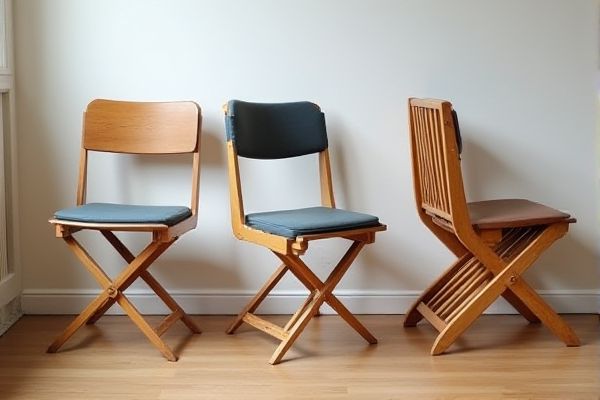
Folding chairs offer easy portability and compact storage by collapsing flat, making them ideal for temporary seating needs, while stackable chairs save space by neatly piling one on top of another, perfect for organized, permanent setups. Discover which type suits Your space and event requirements by reading the rest of the article.
Table of Comparison
| Feature | Folding Chairs | Stackable Chairs |
|---|---|---|
| Design | Hinged frame folds flat | Designed to nest atop each other |
| Storage | Compact, folds flat for minimal space | Stacks vertically, saves floor space |
| Portability | Lightweight and easy to carry | Less portable, bulkier when stacked |
| Use Cases | Temporary seating, events | Permanent or semi-permanent setups |
| Durability | Varies; often less sturdy | Generally robust for frequent use |
| Setup Time | Fast open and close | Requires unstacking |
| Cost | Usually affordable | Often higher price due to sturdiness |
Introduction: Folding Chairs vs Stackable Chairs
Folding chairs offer portability and easy storage by collapsing flat, making them ideal for temporary seating in events or small spaces. Stackable chairs provide durable, space-efficient storage by nesting securely on top of each other, suited for multi-use venues and offices. Choosing between folding and stackable chairs depends on the balance of mobility requirements and long-term storage needs.
Design and Structure Comparison
Folding chairs feature a hinged design that allows quick collapse and compact storage, making them ideal for portable use and space-saving needs. Stackable chairs are constructed with sturdy frames and flat surfaces, enabling multiple units to be neatly piled vertically without folding, which enhances stability and accessibility in fixed spaces. Your choice depends on whether portability or efficient stacking suits your venue's layout and usage patterns.
Space Efficiency and Storage
Folding chairs offer exceptional space efficiency by collapsing flat, enabling easy storage in closets, under beds, or in compact areas, making them ideal for small spaces. Stackable chairs optimize storage by allowing multiple units to be piled vertically, saving floor space and speeding up setup and cleanup in environments like event halls or conference rooms. Your choice between folding and stackable chairs depends on your specific needs for portability and the amount of available storage space.
Durability and Material Choices
Folding chairs often feature lightweight metals like aluminum or steel, paired with vinyl or fabric seats, balancing portability with moderate durability. Stackable chairs commonly utilize sturdier materials such as solid wood or reinforced plastic, designed to withstand frequent stacking and heavy usage without compromising structural integrity. Your choice between folding and stackable chairs should consider the material's resilience to wear and tear based on intended use, ensuring long-term durability in demanding environments.
Comfort and Ergonomics
Folding chairs often feature simple designs with basic padding, which can limit long-term comfort and ergonomic support, especially for extended use. Stackable chairs typically offer more contoured seating and backrests designed to promote better posture, making them a preferred choice for venues requiring sustained comfort. Ergonomic considerations in stackable chairs include lumbar support and seat cushioning, enhancing overall user comfort compared to most folding chair models.
Portability and Weight
Folding chairs offer superior portability due to their compact design when collapsed, making them easy to carry and store in tight spaces. Stackable chairs are generally heavier because of their solid construction, which can reduce ease of transport but enhances stability for extended use. Your choice between these options depends on whether lightweight convenience or sturdy durability aligns best with your needs.
Setup and Cleanup Convenience
Folding chairs offer rapid setup and cleanup, making them ideal for events requiring quick transitions. Stackable chairs require more space to stack and may take longer to arrange but are more stable when stored in large quantities. Your choice depends on whether ease of transport or efficient long-term storage is your priority.
Aesthetic Appeal and Versatility
Folding chairs offer a sleek, compact design ideal for modern, minimalistic spaces, while stackable chairs provide a more uniform, polished look suited for formal or large-scale events. Your choice depends on whether you prioritize quick storage and portability or a consistent aesthetic and easy arrangement. Both chair types enhance versatility by accommodating various occasions, but stackable chairs often deliver a refined presentation for professional settings.
Cost and Budget Considerations
Folding chairs typically offer a lower upfront cost, making them an economical choice for budget-conscious buyers who need portable seating for occasional use. Stackable chairs may have a higher initial price but provide long-term value through efficient storage and durability, reducing replacement and storage expenses. When planning large events or frequent use, evaluating the total cost of ownership, including maintenance and space savings, helps determine the most cost-effective option.
Best Use Cases and Recommendations
Folding chairs offer portability and easy storage, making them ideal for events requiring quick setup and frequent relocation, such as outdoor gatherings, trade shows, and classrooms. Stackable chairs are better suited for permanent or semi-permanent seating arrangements in conference rooms, dining areas, and auditoriums, where space efficiency and durability are prioritized. Your choice depends on the need for mobility versus long-term storage and usage, with folding chairs excelling in flexibility and stackable chairs providing stable, compact organization.
 homyna.com
homyna.com